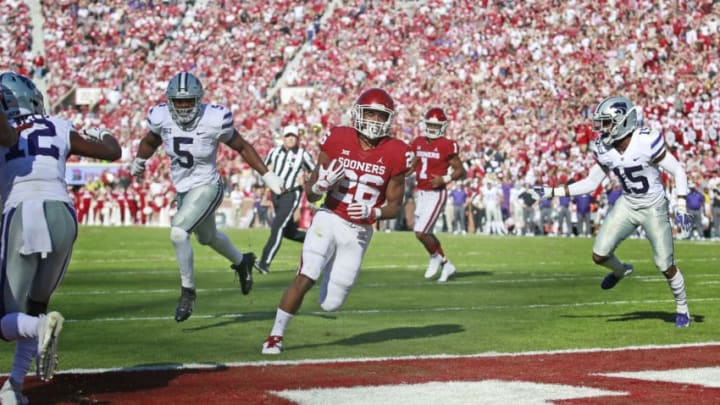For as long as I can remember, Oklahoma football has been known as the home of some of the greatest running backs in college football history.
Billy Vessels, Billy Sims, Steve Owens, Greg Pruitt, Joe Washington, Adrian Peterson, Samaje Perine…the list goes on and on.
Running the football has always been the power behind the high-octane offenses that have long been an indigenous part of Sooner football. Even today, with Oklahoma putting up monstrous numbers on the field and on the scoreboard, the run game is a pivotal part of the Sooners’ success on offense.
With a legacy of Heisman Trophy winning quarterbacks and a roster deep with talented playmakers at the receiver position — and running backs and H-backs who double as receivers — it’s easy to deduce that the Sooners employ their Air Raid offense to set up the rushing attack.

Oklahoma Sooners Football
I believe it’s the other way around: the ability to run the football serves as the catalyst to open up the field for the Sooners’ explosive aerial game.
At this time a year ago, however, OU and newly installed running backs coach DeMarco Murray were faced with an uncharacteristic offensive dilemma. The Sooners were without of their top-four rushing leaders from the year before. Jalen Hurts went to the NFL, Trey Sermon transferred to Ohio State and Kennedy Brooks elected to opt out of the 2020 season because of the COVID-19 pandemic.
In addition, Rhamondre Stevenson was suspended for five games because of failing a drug test prior to OU’s 2019 College Football Playoff game against LSU.
Those four individuals accounting for 94 percent of Oklahoma’s rushing yards in the 2019 season.
Stevenson didn’t rejoin the team until the Sooners’ sixth game of the 2020 season. For more than half the season, the running back room consisted of true freshman Seth McGowan, redshirt sophomore T.J. Pledger, who was returning from injury, and redshirt freshman Marcus Major.
Through the first five games of the pandemic-altered 2020 season, averaged just over150 yards a game and under four yards per rushing attempt, almost 100 yards fewer than the prior season.
The OU rushing attack regained some of its old form upon Stevenson’s return last season. In fact,, the Sooners ran for 435 yards in a postseason Cotton Bowl win over Florida.
Brooks announced late last season that he planned to return for the 2021 season, which was clearly good news for Sooner fans, but beyond Brooks — a 1,000-yard rusher in each of his previous two active seasons, what once was a deep and fully charged Oklahoma backfield had suddenly become a major cause for concern.
During this past offseason, Stevenson declared for the NFL Draft, Pledger entered the transfer portal and is now at Utah, and McGowan has been dismissed from the team because of his alleged involvement in a robbery attempt.
As good as Brooks had been in both the 2018 and 2019 seasons, there is no assurance of what he will be like after sitting out an entire year, and there was little depth or experience behind him.
After the first of this year, however, the Sooners’ running back misfortunes began to turn around. Former Tennessee running back Eric Gray announced he and two of his teammates were transferring to Oklahoma. Gray led the Volunteers in rushing as a sophomore last season with nearly 800 yards and four touchdowns along with 254 receiving yards and two receiving touchdowns. Gray has two years of eligibility remaining.
A week ago, former four-star LSU running-back prospect Kevontre “Tre” Bradford announced he was transferring to OU. He is reportedly enrolled and now with the Sooner team.
The OU coaching staff is also high on a couple of walk-ons — Todd Hudson and Jordan Knowles — and who are on the roster and were impressive in the recent spring game. Hudson recorded 38 yards on three carries in the spring game; Knowles ran for 31 yards on three rushing attempts, including a touchdown run.
While the Sooners appear to have stabilized, even strengthened, the running-back situation for the time being, what about future years? There is some concern that OU did not recruit a running back in its incoming 2021 class, but the Sooners’ No. 5-ranked 2022 class already has commitments from Gavin Sawchuk, rated the No. 2 running back nationally, and Raleek Brown, the No, 4 RB prospect in the class.
Sawchuk pledged this past week, while Brown has been committed to the Crimson and Cream since February. And there are a couple other top running back prospects on the Sooners’ 2022 and 2023 target lists.
Spoiler alert for opposing defenses and their defensive coordinators: Don’t expect Oklahoma to rely any less or expect any less production out of its running backs in 2021 than it ever has. The OU offense is expected to be a high-powered as ever and that won’t be without a complementary contribution from the Sooner running backs.
